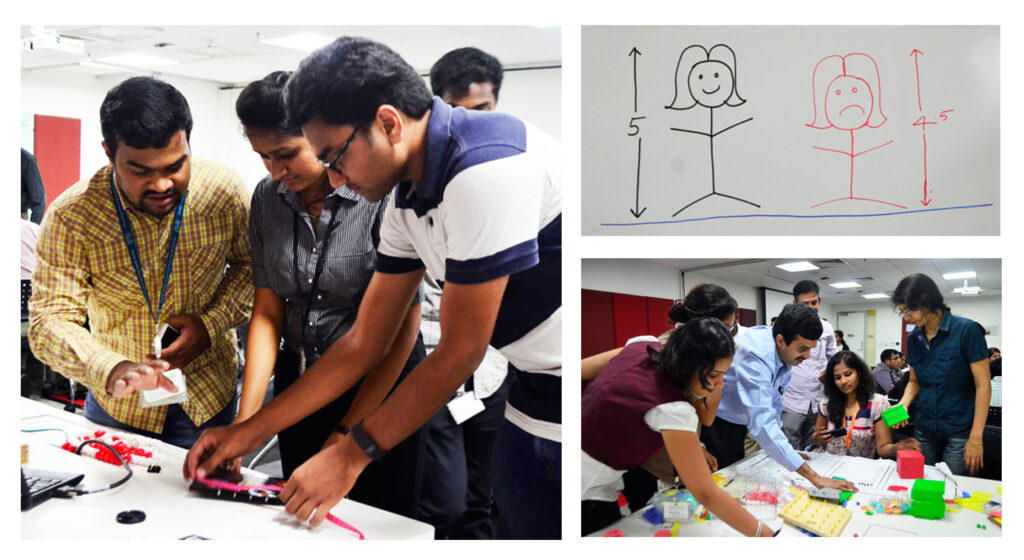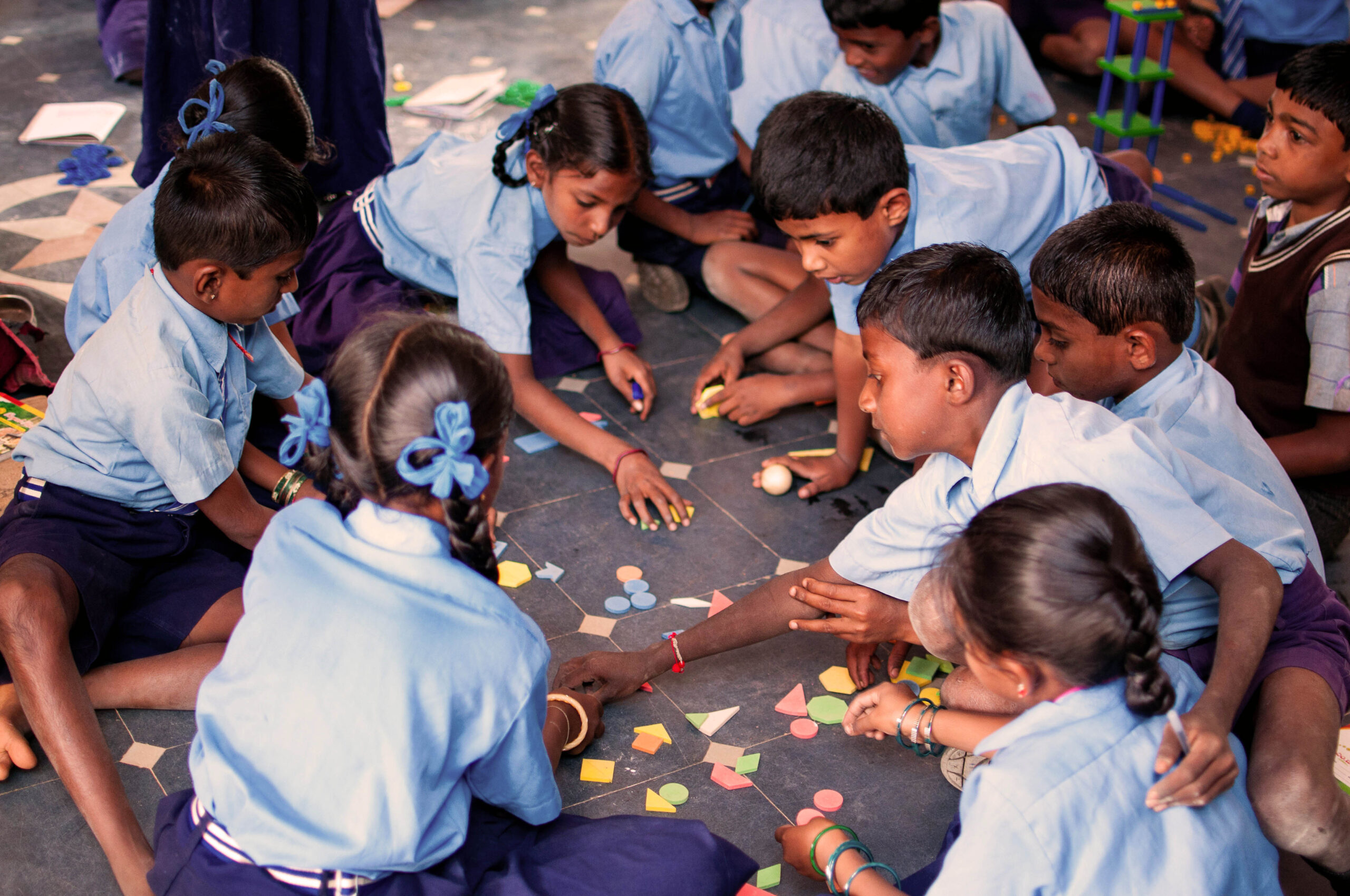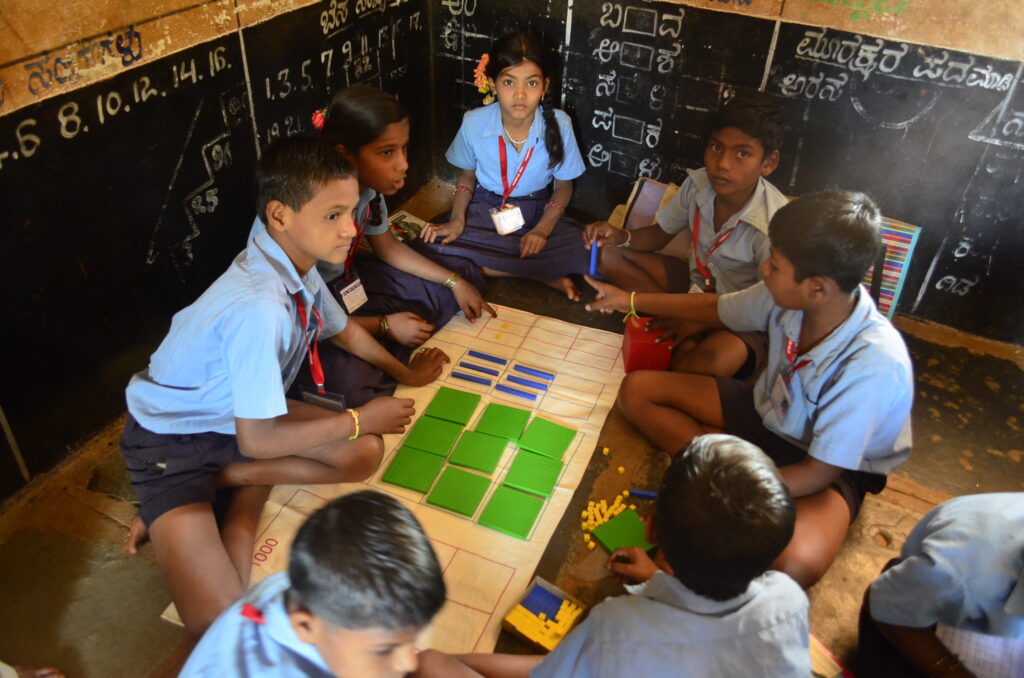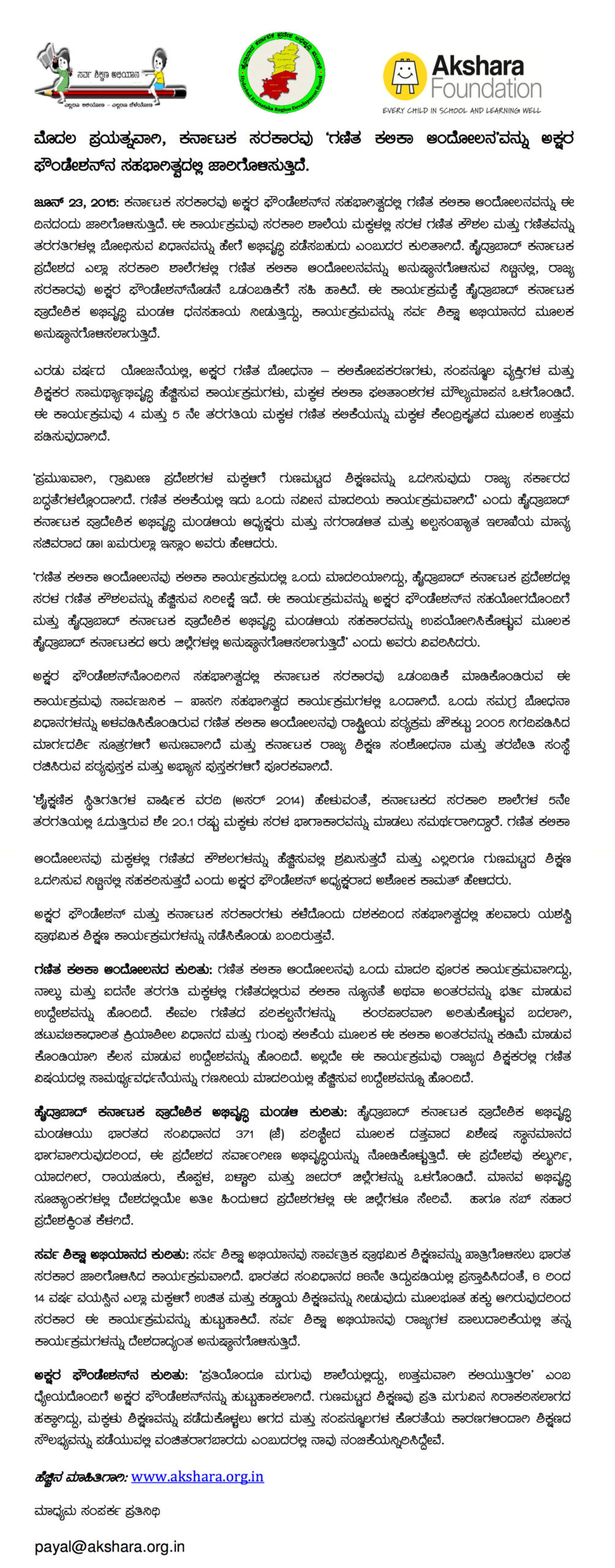Dr. Annapurna Kamath is the Content developer and Master Trainer for the Akshara Ganitha programme. She shares with us her views on the importance of Mathematics and its learning.
 |
| Dr Annapurna Kamath conducting a training session |
• Please let me have your background. What do you do? How long have you been in your profession?
I am a Doctorate in Computer Science and Applications. With an M.Sc in Computer Software, I started my career in the IT Industry and then moved to academics as I am passionate about teaching. I have been using every opportunity to teach since my college days. I worked as Associate Professor and Head, MBA Systems Department, at Mount Carmel Institute of Management. Then I moved on to Head the MCA Department at Mount Carmel College. I was responsible for establishing the Department. Then I took a break and got into early childhood education. I had been pursuing this part time through Shishulok – The Child’s World – a child resource centre, when I was working with Mount Carmel as I loved working with children. This was a weekend programme then, which I made into a full-time centre after quitting my job at Mount Carmel.
Working with higher education I felt a need to lay a strong foundation at the foundation level and also make learning fun so that children look forward to learning rather than come to schools and colleges because it is the norm. There was a lack of enthusiasm to learn in students and their only goal was to score, which worried me. Shishulok was operative as a full-fledged centre for about four years where I offered day care, infant/toddler/preschool programmes and also ran an activity centre. I worked with a lot of young children trying to make learning fun. I eventually converted this into a part time centre. Now I only offer announced programmes and have discontinued the full day programmes.I conduct programmes for parents and children and educators. We also have a private charitable trust called Satya Foundation (www.satyafoundation.in) through which we work in one area across verticals. As part of this I work with anganwadis and government schools, in vocational training for women, the environment, and community projects. I have been teaching since 1998.
• Please tell me about your relationship with Mathematics. How passionate are you about it? What are your experiences with it?
I would say I am passionate about Mathematics. Mathematics has always fascinated me. When I worked in the higher education level I found that many students do not like Mathematics as they are not interested in it, and sometimes do not understand it as they are unable to visualise it or relate it with real life. This makes it the most dreaded subject. This is when I felt the need to focus more on foundation Mathematics. With the early childhood centre, I started focusing on making Mathematics fun for children by teaching using multiple intelligences and also in a progressive way by focusing more on understanding and application than drill work. This started my journey with Mathematics at a teaching learning level. In 2004 when I registered for my PhD in Computer Science and Applications, I chose Mathematics-related work as my topic of research. The topic was:The Design and Development of a Learning Model to Optimize Mathematical Pathways using Mathematical Modelling and Computer based Techniques. This involved using an effective teaching environment, the right methodology and strategies in classrooms to teach Mathematics; the use of assessments to collect data; and analysing the data to refine the learning model. Thus began my close association with Mathematics.
• Why is Mathematics important? What, in your opinion, is its connection to life as we live it?
Mathematics is the backbone of all disciplines. Everything has Mathematics in it and we use Mathematics in some form everywhere. Where there is a need for accuracy and precision we need Mathematics. Survival calls for a minimum knowledge of Mathematics – buying, selling, money management, banking, saving, insurance, all have Mathematics in them. Hence, Mathematics is an all important subject which has unique features:It develops the child’s reasoning power;sharpens their intelligence;makes their thinking clear and exact;develops their ability to make numerical calculations; and forms the basis in the study of all subjects related to science and commerce.
• Why do you think Mathematics is a must for children, particularly government school children? What are their problems with it?
Mathematics is a must for all children as it is an essential ingredient needed to lead life. All children, without an exception, have problems with Mathematics. Mathematics phobia is a very common issue. Children start with a liking for Mathematics in the initial years and then grow to dislike it and also develop a fear for it. Children wait for the first opportunity to drop it and get away from it. This is because of the approach to teaching and learning Mathematics. Mathematics in the traditional education system has been more of a chalk-and- board, and drill oriented, textbook approach. Pencil and paper do not make Mathematics a sensorial experience. Children are unable to experience Mathematics using their senses. They cannot visualise Mathematics, feel Mathematics, and work with it. They are made to learn the procedures of handling it and apply it by repeated solving of problems. Here, a couple of children understand the procedure and apply it; the rest rote-learn it using their own methods of memorization. This leads to them not being able to understand higher order Mathematics or experiment with Mathematics.
For the teacher also making children understand Mathematics remains doing more and more problems of a similar nature till such time that they understand. They are not equipped with tools to unravel the mysteries of Mathematics. Once a child experiences Mathematics by discovering its intricacies, he will start loving it. A teacher/child needs to understand Mathematics and assimilate it so that they can start associating it with all things around them, which is not happening in schools. Children are well versed in solving written problems and their Mathematics ability is measured by the number of problems they can solve correctly in a given span of time rather than by their ability to see it in things around them and use it in daily life.
• Why is it that children in government schools cannot do simple, basic Mathematics? Is it the teaching of it that is at fault? The kind of textbooks? The environment? Or is it that Mathematics is sometimes too complex for them to comprehend?
You will be surprised that children in private schools also face the same problems except that they have additional support through parent-backup and tutors, because of which they cope.
• In government schools there are also administrative issues – 2 teachers for all 5 classes, Std. 1 to 5. Government trainings and meetings, which sometimes means the entire school is left to be managed by one teacher without any help. Realising this, this year they have cut down on trainings and sharing meetings to give more classroom time to teachers.
• A teacher is responsible for teaching all subjects, so the workload stresses the teacher and demotivates her from using innovative teaching techniques, which need more time. Her natural instinct will be to cut down on time. By convincing and reassuring them, they do take that bold step towards implementing new methodologies.
• Also, as the focus of the Department of Education and Inspectors who visit schools from time to time is syllabus completion,teachers are also forced to work towards these goals.
• Textbooks, though well researched and written by eminent educationists, focus more on drill work and not discovery learning. Slowly, we are seeing a change in this too. This year’s textbooks are more promising.
• Infrastructure-wise also teachers have space and TLM availability issues, and time constraints to make their own TLM. So when provided with readymade TLM they are more enthusiastic to use that rather than engage in a do-it-yourself venture.
Generally Mathematics is made to seem complex as children hear adults discussing their hatred for it, sometimes maybe lightly.Very few adults express a love for Mathematics and work with children to make it seem enjoyable. The general worldly response is that Mathematics is difficult. Until the approach to Mathematics is changed, Mathematics will seem like a very difficult subject. Until we make a transition from teaching Mathematics for procedural fluency to concept clarity we will have children who will never be able to appreciate Mathematics. Also, when concepts are clear children will find their way with procedures, one does not have to spend a lot of time with them.
To make Mathematics a success at the school level there has to be a complete change. Change in content (the NCF framework is good);the use of concrete to abstract approach;the use of TLM to make it sensorial;effective teacher training; constant teacher motivation and hand holding till they achieve their goals.
• What do you think needs to be done in government schools to further Mathematics? Surveys show that 8 out of 10 children in class 5 cannot do simple division.
Focus on making children familiar with concepts. Work with children to ensure they have understood the concept. Develop in children a liking for Mathematics. Make Mathematics seem fun and enjoyable. Do not drill procedures into them and do not punish them by making them solve 10-20 problems of the same kind. Once a child learns to solve a problem, repeated solving does not pose a challenge. Rather, increasing the complexity of the problem and challenging them would not only improve their mathematical abilities but also enhance their interest.
• How did you become involved with Akshara Ganitha?
I was associated with Akshara as an English trainer for ‘Swalpa English Thumba Fun’ through a friend. That is were I met Vikas and we got discussing the Mathematics pedagogy. When I revealed the topic of my research work he asked me if I would be interested in working with Akshara. The challenge of the task and the reach Akshara Ganitha would have to deserving children prompted me to agree immediately. That’s how I began the Akshara Ganitha journey. I studied the existing Nagu Nagutha Ganitha programme and met a lot of teachers who were using it. We collected feedback from them. There was great appreciation for the Nagu Nagutha Ganitha programme among teachers. Some of the problems they were facing with it were that it was remedial in nature and running parallel to their curriculums, which did not give them enough time to implement it, as syllabus completion was always the priority. They wanted something that would work along with their curriculums. Initially, the thinking was to improvise on Nagu Nagutha Ganitha. We had a meeting with CRPs and teachers of Hoskote Block. During this meeting we analysed the needs of the schools. They were open to the idea of making Mathematics interactive.
• They said they would be happy to use the TLM, but were very clear that they had no time to make them. They wanted sturdy, long-lasting TLM that would save them the time of preparing them.
• They wanted workbooks to be used, but printed ones.
• They wanted the new approach integrated in their lesson plans and brought up-to-date with their syllabuses so that they did not have to write the lesson plans and would not have to worry about surprise inspections.
• Assessments to help with CCE.
With these inputs we came back and planned the design of a new programme and called it AksharaGanitha, ‘Aadi Kali MaadiTili’. The components, as needed by teachers,were a TLM kit, workbook, lesson plans and assessments.
• What were the aspects you had to focus on with particular emphasis, since it is a programme for government school children?
• Provide TLM to teach every concept of lower primary school Mathematics, but keep it limited so that management and handling becomes easy.
• Make the TLM kit economical so if they have to buy it tomorrow or the government wants to adopt the programme, cost does not become a hurdle.
• The workbook to be kept simple and containing minimum worksheets that cover all concepts so that they are not pressed for time to do them.
• Brief lesson plans to bridge the gap between the new methodology and the syllabus.They must be short enough for teachers to read before a class.
• The main challenge was to give them a progressive, age-appropriate Mathematics programme for Std. 1 to 5 with TLM, workbooks and assessments that would be easily adopted by the teachers without resistance.
• What was the process you followed? Did you visit government schools and talk to teachers and children? What was the Akshara team’s role in developing Akshara Ganitha? Was it a collaboration?
I always adopt a systems approach to any new design and development. I believe that any programme designed has to be finally acceptable to the end user. Without end-user participation,a programme is bound to fail. So our requirements came from the teachers and CRPs and BEO. Now how to package this in an optimal way was our effort. We used prior knowledge about Mathematics learning, researched hard into different ways in which we could make this effective, sought help from experts, organised workshops with people already working in this area (Vivek Montero and Geeta from Navanirmitti), made sure no stone was left unturned.
It was a team effort. Yes,collaboration. We had a lot of brainstorming sessions. I would prepare a skeleton and then we would discuss if all were in sync. Sometimes if Vikas was struck by a novel idea he would do the skeleton and we would bisect and dissect to reach at the final structure. Kishore and Suman would also give their inputs. Suman has worked closely with Nagu Nagutha Ganitha and has field experience. So it has been a rigorous process of exploring, improvising and packaging. Like the TLM, which was not our invention – but what to use, how to use it and improvisations to make them appropriate were our contribution. The lesson plans were designed by us and the workbooks too. The first time Ten on Ten did our workbooks. The next time the team designed it.
We had excellent team dynamics and a wonderful dedicated team. Each one did their bit and under what time constraints and deadlines! Vikas was a wonderful team leader.
I have worked with young children during my Shishulok days and that helped, along with my teaching experience. Designing programmes, curriculums and new start-ups have always been my strength.
We wrote the entire Teacher’s Manual in English, got it reviewed and then translated it into Kannada with the help of school teachers. As they translated they also reviewed it. So it got a second review. Once the draft was ready I reviewed it again for typographical, grammatical and conceptual errors as I can read and write Kannada and I do review work for publications like Appu Media.
Training again is my strength, so this was again not a problem as I could speak Kannada. Yes, it was an effort to get familiar with all the Kannada terms in Mathematics, but during our Manual journey we also developed our own dictionary of terms!
It was a run against time. But a determined and dedicated team made it possible to deliver the programme on time. Once it was in the field we did regular studies and collected feedback and refined the programme.
As with the case of any educational venture there is no end.It is a journey of refining and enhancing quality. The show will never end. Our attempts are to make it better with each day. The first year we focused on arithmetic as it is the backbone of primary Mathematics and made it as complete as possible. We have a little work left with geometry and measurements.
Our motivation has been the teachers who are working on this programme and give us constant feedback. They are all happy and have accepted it with a positive attitude. They tell us that they are able to understand Mathematics better with the programme and that it is helping them teach better, and that children love Mathematics so much they are becoming good at it. This is our motivation and strength. Our dream and desire is to make AksharaGanitha available to every government school in Karnataka, and the country, so that every child loves Mathematics. Looking forward to that day when this programme becomes a part of the system.


























